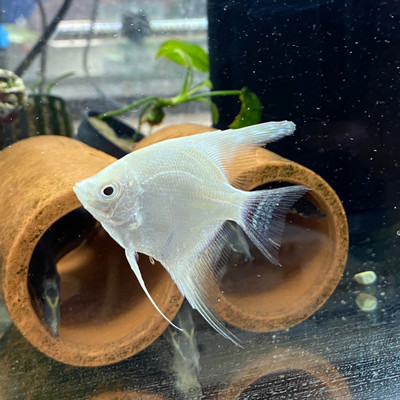Platinum Angelfish
Posted by Max Gandara on on 7th May 2025
Platinum Angelfish: The Silver Star of Freshwater Aquariums
Few freshwater fish exude the grace and elegance of the Platinum Angelfish. With its gleaming, metallic sheen and regal demeanor, this stunning angelfish variety is a favorite among aquascaping enthusiasts and community tank keepers alike. Whether you're setting up your first show tank or enhancing an existing setup, the Platinum Angelfish adds a touch of class and calm to any aquarium.
What is a Platinum Angelfish?
The Platinum Angelfish is a selectively bred variety of the freshwater Angelfish (Pterophyllum scalare). What sets it apart is its solid, iridescent white or silver coloration that shimmers beautifully under aquarium lighting — a result of genetic selection for the "platinum" trait.
-
Scientific name: Pterophyllum scalare
-
Size: Up to 6 inches in body length, 8+ inches tall with fins
-
Color: Uniform metallic white/silver
-
Fins: Long, flowing, and translucent
Its minimalist coloration and elegant form make it a sought-after choice for minimalist or modern-style aquariums.
Behavior and Temperament
Platinum Angelfish are generally peaceful, but they can become territorial, especially during breeding or when housed in cramped quarters.
-
Temperament: Calm and curious
-
Social behavior: Best kept in groups of 4–6 juveniles, or as a pair once mature
-
Aggression: Mild, but may chase smaller or long-finned tankmates
They're intelligent and may recognize their owners, often greeting them at the glass at feeding time.
Tank Setup
To keep your Platinum Angelfish healthy and thriving, you'll want a tank that matches their natural tendencies and aesthetic needs.
Recommended parameters:
-
Tank size: Minimum 30 gallons for a pair; 55+ gallons for a group
-
Temperature: 24–28°C (75–82°F)
-
pH: 6.5–7.5
-
Hardness: Soft to moderately hard water
-
Aquascape: Vertical space is key — use tall plants (like Amazon swords), driftwood, and gentle filtration
-
Lighting: Moderate to bright (brings out the sheen in their scales)
Avoid strong currents, as angelfish prefer slow-moving waters, similar to their native Amazon basin.
Diet
Platinum Angelfish are omnivores, and they benefit from a varied, protein-rich diet.
Feeding suggestions:
-
High-quality flake or pellet food as a base
-
Supplement with frozen bloodworms, brine shrimp, or daphnia
-
Occasional blanched vegetables (spinach, zucchini) for variety
Feed 1–2 times daily and remove uneaten food to maintain water quality.
Tankmates: Choose Peaceful Companions
Angelfish do best in a peaceful community but can be fin-nippers or get nipped in return, depending on tankmates.
Ideal tankmates:
-
Corydoras catfish
-
Gouramis (dwarf, pearl)
-
Peaceful tetras (rummy nose, lemon, or cardinal — avoid nippy ones like serpae)
-
Bristlenose plecos
-
Mollies and platies (in larger tanks)
Avoid:
-
Small fish that could be seen as food (e.g., neon tetras if introduced later)
-
Fin-nippers like tiger barbs
-
Other aggressive cichlids unless in a very large tank
Breeding
Breeding Platinum Angelfish is possible with a compatible pair and stable tank conditions.
-
They are egg layers, often depositing eggs on flat surfaces like leaves or tank glass
-
Parents may guard the eggs and fry
-
Separate breeding tanks improve survival rates of fry
Feeding fry with infusoria or baby brine shrimp is essential for early development.
Lifespan and Health
With good care, Platinum Angelfish can live 8–10 years.
Common health concerns:
-
Ich (especially after sudden temperature drops)
-
Fin rot (usually from poor water quality)
-
Hexamita/hole-in-the-head disease (from poor nutrition or water conditions)
Maintain stable water parameters and a clean tank to prevent issues.
Final Thoughts
The Platinum Angelfish isn’t just a fish — it’s a statement. Sleek, graceful, and radiant, it adds sophistication and charm to any tank. Whether you're a seasoned aquarist or a beginner ready to invest in a showpiece species, the Platinum Angelfish is a fantastic choice.
Just give them space, clean water, and the occasional treat — and they'll rule your aquarium like true freshwater royalty.

